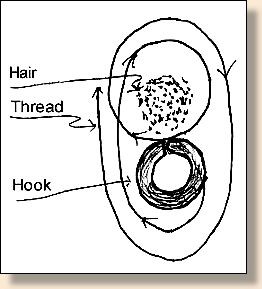Lesson 1 - Greaser Liner
This lesson will deal with dry flies that are used for Salmon
and/or Steelhead. Most of us know that there aren't anywhere
near as many top water flies used for these majestic fish as
there are sub surface patterns. Also, with the exception of
the Wulff series of flies, the majority of the dry patterns
are more likely to be "damp" flies. That is that rather than
riding high and dry, these flies rest in the surface and many
of them are fished in a "skating" fashion rather than a typical
dead drift.
Harry Lemire's Greased Liner actually uses a typical wet fly
throat hackle and relies on the bushy Deer hair tail and wing
for flotation and a shaped deer hair head that will assist in
skating.
The first pattern I choose to present is the Greased Liner which
is a simple fly to tie and one that has accounted for many fish
over the years.
Harry's recipe calls for a pretty bushy Deer hair tail and a
Deer hair wing with that element extending to the end of the
dubbing body.
This pattern can also be tied in other colors with an orange
body being extremely effective when the October Caddis is in
the air.

Greased Liner by Harry Lemire
Tied by Ronn Lucas, Sr.
Hook: Light wire of choice, I used Partridge Single Wilson.
Tail: Deer hair, and full.
Body: Original calls for dark grayish tan to black fur.
Throat: Sparse grizzly hackle.
Wing: Dark Deer hair extending to the end of the body
with the butts shaped as shown.
Instructions: Greased Liner

1. Lay down a tight thread base under the tail tie in area
and tie in a fairly good size bunch of Deer hair. I rarely
stack my Deer hair anymore but do it if you like that better.
The reason I don't is because the tips in un-stacked hair
looks more mottled than when it is stacked. Just a personal
preference and likely has no effect on the fish.

2. Dub the body ending well behind the eye to leave plenty
of room for the shaped head. I used brown Iridescent Dubbing
on this fly. Also, the first turn of dubbing is over the
thread wraps of the tail so it confines the Deer hair.
Lay down a tight thread base in the wing tie in area.

3. Tie in some grizzly hackle barbs throat style.

4. Tie in a good size bunch of Deer hair for the wing.
I use the "EHC Wing Bundle Technique" described in this
illustration to tie in the wing. This allows you to secure
the wing without it spinning around the hook. Tie the wing
in VERY tightly! Be sure you have 100% compression of the hair.

This technique for tying in a wing or other material
keeps the material from rolling around the hook. What you
are doing is making a bundle of the material and, tying it
in as a single unit. The trick to doing it successfully is
twofold. First, all of what the illustration shows is done
with a "soft loop." That is, no tension on the thread at
all until the thread comes around the hook the second time.
At this point, you are holding the hair tightly with the
left hand close to the hook and with the right hand begin
to slowly pull up to the point that the bundle begins to
compress. Come around once more with tighter thread tension
to compress the bundle even tighter. By the third turn, you
should have maximum compression that is vital. These turns
of thread need to be made side by side going forward from
the first soft loop. If at any point you make a turn of
thread behind that loop, the hair will try hard to spin
around the hook. With your three or four turns done, tie
in the tag veil taking the same number of tight, flat,
close turns back to just short of the first turn.
5. Shape the head as shown. You can also shape it more wedge
like if you prefer. I tied off and whip finished under the
wing hair butts to kick up the butts a bit. You can also whip
finish on the wing tie in area. While I seldom put head cement
on my fishing flies, it always put a little cement on the wraps
on a wing such as this even on fishing flies. I like to let some
"wick" into the wing to help hold its shape.

As always, I am happy to answer any questions you might have
about these patterns. You can reach me at
rlucas@cybcon.com or 503-654-0466.
Also, I will be happy to accept any flies you would like to tie
and send to me for inclusion in this series. I will need the
fly, it's recipe, any pattern info and, a short personal bio.
I will try to include every fly we get in the appropriate
section. The only limitation is that the patterns used must
be for Salmon and/or Steelhead. This includes the display
flies too.
Happy Trails! ~ Ronn Lucas, Sr.
Back to Index
|



